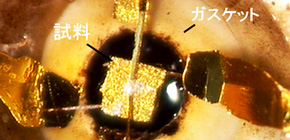
Multiferroics -- promising materials for electronic devices
Multiferroics possessing properties approximating that of conventional ferroelectrics were realized
A joint group of researchers at Osaka University have found that multiferroics possessing both magnetic order and ferroelectric order greatly increased ferroelectricity induced by magnetic order through the application of high pressure.
Osaka University affiliations of the members of the research team:
Graduate School of Engineering Science:
• KIMURA Tsuyoshi , Professor
• AOYAMA Takuya , 3rd year of doctoral program. (Also, Fellow, Japan Society for the Promotion of Science)
• SHIMIZU Katsuya , Professor
Institute of Scientific and Industrial Research:
• YAMAUCHI Kunihiko , Assistant Professor
As properties of multiferroics can be controlled by methods different from normal methods such as magnetization by an electric field and electric polarization by a magnetic field, new devices such as magnetoelectric conversion devices have been sought after and developed in the last decade. Among multiferroics, particularly in multiferroic materials in which ferroelectricity is caused by magnetic order, giant magnetoelectric effects (drastic changes in ferroelectricity by a magnetic field) are occasionally observed.
This research group developed a measurement system for examining at 10K pressures by making use of a diamond-anvil cell and examined, under a high pressure, the details of ferroelectric properties of TbMnO 3 , a multiferroic induced by magnetic order. As a result, it was demonstrated that ferroelectricity in TbMnO 3 was 0.07μC/cm 2 at normal pressures, but at 40K or higher pressures, the value increased to an order of magnitude larger than that at normal pressures, 1μC/cm 2 . Furthermore, this enhanced ferroelectricity induced by magnetic order further, by being applied to a magnetic field, was enhanced, almost doubled, to 2μC/cm 2 . This value was nearly an order of a magnitude larger than values ever reported in spin-driven ferroelectrics.
This group has also clarified that the increase in the observed ferroelectric polarization was caused by pressure-induced magnetoelectric phase transition. Furthermore, this group demonstrated that multiferroics possessing properties approximating that of conventional ferroelectrics were realized and their ferroelectric polarization could be controlled by a magnetic field.
Currently, operation has been achieved only at high pressure and at low temperatures, therefore, there are many problems remaining in moving forward in the practical use of ferroelectricity control by magnetic fields and magnetic control by electric fields. However, ferroelectric polarization induced by magnetic order that had been thought to be far smaller than that of conventional ferroelectrics could be greatly increased by pressure, which suggests possibilities for multiferroic property control not only by electric fields and magnetic fields, but also by pressure. In the future, this group's achievement in the use of multiferroics will lead to the development of electric, magnetic, and optical materials as well as devices working on different principles.
Abstract
The recent research on multiferroics has provided solid evidence that the breaking of inversion symmetry by spin order can induce ferroelectric polarization P. This type of multiferroics, called spin-driven ferroelectrics, often show a gigantic change in P on application of a magnetic field B. However, their polarization (<~0.1 μC cm −2 ) is much smaller than that in conventional ferroelectrics (typically several to several tens of μC cm −2 ). Here we show that the application of external pressure to a representative spin-driven ferroelectric, TbMnO 3 , causes a flop of P and leads to the highest P (≈1.0 μC cm −2 ) among spin-driven ferroelectrics ever reported. We explain this behaviour in terms of a pressure-induced magnetoelectric phase transition, based on the results of density functional simulations. In the high-pressure phase, the application of B further enhances P over 1.8 μC cm −2 . This value is nearly an order of magnitude larger than those ever reported in spin-driven ferroelectrics.

Figure 1

Figure 2

Figure 3
To learn more about this research, please view the full research report entitled " Giant spin-driven ferroelectric polarization in TbMnO 3 under high pressure " at this page of the Nature Communications website.
Related link :
